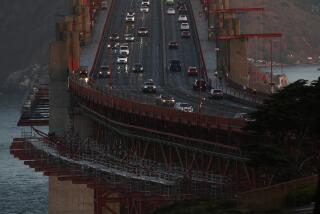Cable barriers, distance dots meant to keep roads safer
- Share via
DAYTON, OHIO — A hornet sting made trucker Christopher Adams lose control of his semitrailer at 70 mph. Three cables may have saved his life.
A steel-cable barrier that Missouri had installed a few weeks earlier snagged his truck in the median of Interstate 44, keeping it from barreling into oncoming vehicles or from ricocheting back into traffic.
“If the cables wouldn’t have been there, I would have gone clear across the interstate,” said Adams, 58, of Payette, Idaho. “No one got hurt. That was amazing.”
To improve traffic safety without busting their budgets, states are installing the cable barriers, painting distance dots on roads to discourage tailgating and placing stop signs that light up like Christmas trees at dangerous intersections.
North Carolina uses poles called channelizers that protrude from center lines to keep motorists from sneaking through gates at railroad crossings.
Naperville, Ill., has installed flashing beacons on the back of school zone signs to remind motorists of the lower speed limit when they look in their rearview mirrors. In Milwaukee, a series of white chevrons painted on highways give motorists the illusion of going faster to get them to slow down as they approach exit ramps.
The cost of steel, cement, asphalt and diesel fuel is up. And with traffic on the rise, states are spending many of their transportation dollars on building new roads and expanding existing ones. That leaves limited funds for safety improvements and forces engineers to look for lower-cost solutions.
Last year, the number of traffic deaths nationwide was the most in a single year since 1990, and the overall fatality rate -- deaths per 100 million miles traveled -- increased for the first time in 20 years.
Ohio has spent $5.5 million since 2003 to install 83 miles of cable barriers and is working on 30 miles of barriers at a cost of $2.2 million.
Ohio had 18 fatal median-crossover crashes in both 2004 and 2005, but no one died in crashes where there were cables.
Missouri has cable on more than 200 miles of interstate highways, about 20% of the state’s total. Only one of every 20 vehicles that have crashed into the cables has gone through the median and into the lanes of approaching traffic.
Adams, who was hauling office furniture near Springfield in southwest Missouri, walked away from his crash with the sting on his forehead and torn stitches from a previous cut on his hand.
The cable barriers also have become popular because of their relatively low cost.
More to Read
Sign up for Essential California
The most important California stories and recommendations in your inbox every morning.
You may occasionally receive promotional content from the Los Angeles Times.













